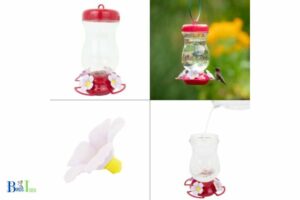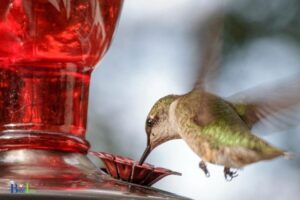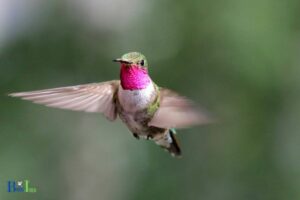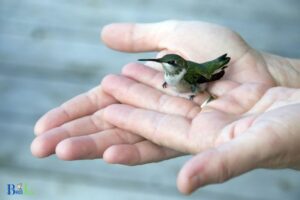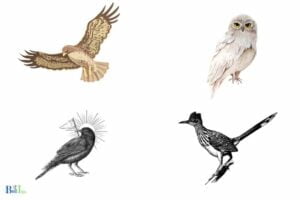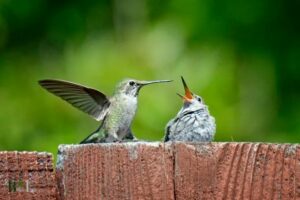How to Open a Hummingbird Feeder: Easy Steps!
Opening a hummingbird feeder is a simple process that requires minimal effort and supplies. First, the feeder should be cleaned with a mild soap and warm water solution before adding the nectar solution.
After the feeder is completely dry, the nectar should be made according to the instructions on the product label and then added to the feeder.
It should then be placed in a location away from direct sunlight and protected from possible predators.
Providing a hummingbird feeder can be a great way to attract birds to your yard but it is important to make sure the feeder is filled correctly and located in the appropriate space.
Birds will frequent the feeder if it is in a safe and accessible area, ensuring bird watchers have plenty of opportunities to view the amazing creatures.
8 Step-by-Step Guide: Opening a Hummingbird Feeder
| Steps | Description |
| 1. Choose the Right Feeder | Choose a hummingbird feeder that opens easily for cleaning and refilling. They usually come in two types: bottle feeders and dish feeders. |
| 2. Prepare | If the feeder is new, rinse it before use. If you are refilling, make sure it’s clean before you add new nectar. |
| 3. Unscrew or Unlatch | Depending on the design, you may need to unscrew the base or unlatch it to open the feeder. |
| 4. Open the Feeder | After unscrewing or unlatching the feeder, gently remove the base from the reservoir. Be careful not to damage the feeding ports. |
| 5. Fill with Nectar | Fill the feeder with prepared nectar. Make sure it fills the reservoir and reaches the feeding ports but doesn’t overflow. |
| 6. Reattach the Base | Carefully screw or latch the base back onto the reservoir, making sure it’s secure to prevent leaks. |
| 7. Hang Up for Hummingbirds | Hang the filled and secured feeder outside where you can observe the hummingbirds coming to feed. |
| 8. Monitor | Regularly monitor the feeder for cleanliness and refill as needed. |
Key Takeaway
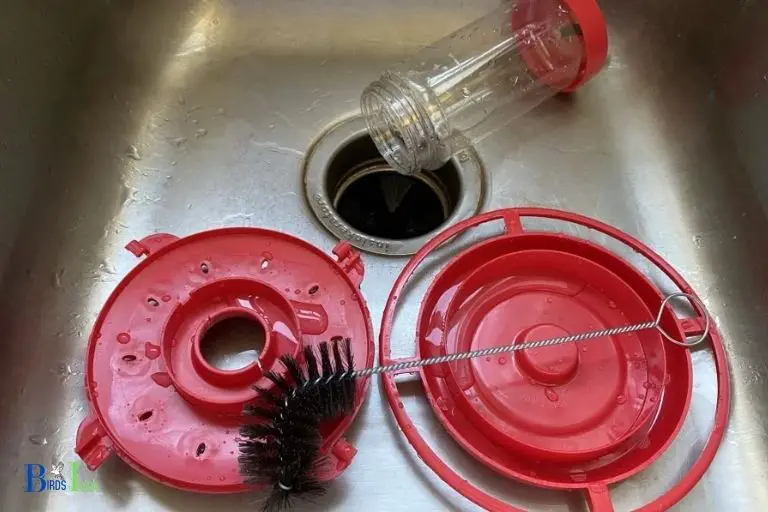
Five Facts About: Opening Hummingbird Feeders
DID YOU KNOW
Hummingbirds are among the smallest birds in the world – clocking in at sizes as small as two to three inches.
Opening a Hummingbird Feeder
Installing a hummingbird feeder will give you the opportunity to observe and appreciate these beautiful birds up close.

Here are the steps to follow when setting up a hummingbird feeder:
- Find a spot in your yard that is sheltered from the wind and direct sunlight.
- Hang the feeder with a hook or bracket.
- Fill the feeder with a mixture of one part white sugar to four parts water.
- Clean the feeder regularly (at least once a week) to prevent the growth of mold and bacteria.
- Place perches around the feeder to attract the birds.
By following these steps, you can enjoy watching hummingbirds feed in your own backyard.
Not only is it a great way to relax and observe nature, but it’s also beneficial to the environment, as hummingbird feeders provide a source of food and water for our feathered friends.
Why Opening a Hummingbird Feeder is Important
Hummingbirds are one of the most beloved creatures in nature. Opening a hummingbird feeder is an excellent way of attracting these beautiful birds to your garden and providing them with the necessary sustenance to survive.

Here are some reasons why opening a hummingbird feeder is important:
- It allows hummingbirds to find food faster. By providing a reliable source of food, hummingbirds can quickly and easily get the nutrients they need to survive.
- It helps to conserve hummingbirds. Although hummingbirds are quite common, they are becoming increasingly threatened by loss of habitat and other natural disasters. By providing a food source for them, you are helping to conserve the species.
- It helps to provide a safe environment for hummingbirds. Hummingbirds are quite vulnerable to predators and other environmental threats. By providing a hummingbird feeder, you are providing them with a safe environment in which to feed.
- It can help to create an enjoyable, relaxing atmosphere. The sight of these beautiful birds flitting around your garden can create a relaxing atmosphere that is sure to make you smile.
Opening a hummingbird feeder is an important way to help conserve and enjoy hummingbirds. By providing a reliable source of food and a safe environment, you can make a positive impact on these beautiful creatures.
“I am very sure that when the double-call of the hummingbird will break over the mountains between the sunrise and sunset you will feel the alchemy within your soul.”
birdsidea
What Supplies Are Required for Opening a Hummingbird Feeder?
Opening a hummingbird feeder requires a few supplies to ensure the birds have a safe and comfortable place to feed.
Below is a list of necessary items:

- Hummingbird feeder: These come in a variety of shapes, sizes, and styles and should be chosen based on the number of birds you expect to feed.
- Hummingbird nectar: This sugar-water solution should be made from four parts water to one part sugar and should be replaced every few days to prevent the growth of mold.
- Perch: Many feeders come with a small perch for the birds to rest on while feeding.
- Ant protector: This will help keep ants from getting into the feeder and scaring away the birds.
- Hanging hook: This will allow you to hang the feeder from a tree or other structure.
- Cleaning supplies: You should clean the feeder at least once a month to keep the nectar fresh and prevent the growth of mold or fungus.
What Are The Steps for Opening a Hummingbird Feeder?
Opening a hummingbird feeder requires a few simple steps:

- Find a suitable location – Hummingbirds appreciate feeders that are in a shady, sheltered spot, away from predators.
- Clean your feeder – Clean the feeder with a mild soap and warm water, rinse it thoroughly and allow to air dry.
- Fill the feeder – Fill the feeder with a mixture of water and sugar in a 4:1 ratio. Boil the water beforehand to ensure it is safe for the hummingbirds.
- Hang the feeder – Hang the feeder from a secure, height adjustable hook.
- Monitor the feeder – Be sure to check the feeder for contamination and mold growth. Change the mixture at least every few days to keep it fresh.
For best results, it’s important to keep the feeder clean, full and in a safe location. By following these steps, you’ll be sure to enjoy the beauty of hummingbirds in no time.
What Should Be Taken Into Consideration When Setting Up a Hummingbird Feeder?
When setting up a hummingbird feeder, there are several important things to consider:

Location:
It’s important to choose a spot that is sheltered from the wind and rain, and preferably where there is some natural cover to provide protection. Hummingbirds also prefer to feed near shrubs or trees.
Cleanliness:
Clean and refill the feeder regularly to prevent the build-up of bacteria or mold. Wash it in soapy water, rinse with clean water, and dry.
Food:
Hummingbirds love nectar, and the best nectar is a mixture of four parts water and one part sugar. Boil the water and sugar for three minutes before filling the feeder to kill any bacteria.
Accessibility:
Make sure the feeder is placed within reach of the hummingbirds and also attract them with a bright color.
Maintenance:
Keep an eye out for wasps that may be attracted to the food, and take appropriate measures to keep them away.
Additionally, check the feeder regularly to ensure that the food is fresh and that the feeder is in good condition.
What Are The Benefits of Having a Hummingbird Feeder?
Having a hummingbird feeder can bring many benefits to your garden.
Here are some of the main advantages of having a hummingbird feeder:

Increased wildlife activity:
Hummingbirds are incredibly beautiful creatures, and having a feeder in your garden will attract them to the area.
You’ll be able to witness their spectacular aerial acrobatics first-hand, and you’ll also be able to take in their vibrant colors and sweet song.
Improved pollination:
Hummingbirds are important pollinators and are able to reach flowers in difficult areas that other pollinators may not be able to access.
This means that having a hummingbird feeder in your garden can help to improve the pollination process in your garden.
Natural pest control:
Hummingbirds are natural predators of small insects like mosquitoes, which can help to keep your garden pest-free.
Additional food sources:
Having a hummingbird feeder in your garden can provide additional food sources for hummingbirds, especially during times when food is scarce.
Overall, having a hummingbird feeder in your garden can be incredibly beneficial, not only for the hummingbirds but also for your garden as a whole.
How to Ensure a Successful Hummingbird Feeder Setup?
Hummingbird feeders are a great way to enjoy the beauty of these delicate birds right in your backyard.
To ensure a successful hummingbird feeder setup, there are a few key steps to take:

Choose the right feeder:
Buy a feeder specifically made for hummingbirds, with several flower-shaped ports for the birds to drink from. Make sure the feeder is easy to clean and fill.
Hang the feeder in the right spot:
Place your hummingbird feeder away from human activity and in a spot that gets a good amount of sun. You should also hang it at least five feet off the ground so cats can’t reach it.
Use the right food:
Hummingbirds prefer a simple nectar made from four parts water and one part granulated sugar. Boil the water before mixing it with the sugar to remove any bacteria and impurities.
Keep the feeder clean:
Change the nectar in the feeder every three to five days to keep it from spoiling. Also, clean the feeder once a week with a mild soap solution to prevent the spread of bacteria.
By taking these key steps, you can ensure a successful hummingbird feeder setup and enjoy hours of entertainment watching these beautiful birds visit your backyard.
FAQ of How To Open A Hummingbird Feeder
What is the best way to open a hummingbird feeder?
Is it necessary to feed hummingbirds?
Are there any tips for maintaining a hummingbird feeder?
Make sure the nectar is changed out every few days and keep the feeders in a shaded area to prevent it from fermenting.
What should I put in a hummingbird feeder?
How often should I refill a hummingbird feeder?
Conclusion
Hummingbird feeders are a great way to attract birds to your yard, as long as they are placed properly and with adequate supplies.
With a bit of initial effort to make and apply the right nectar solution and the right placement, you can provide a safe and welcoming spot for these beautiful birds to feed.

